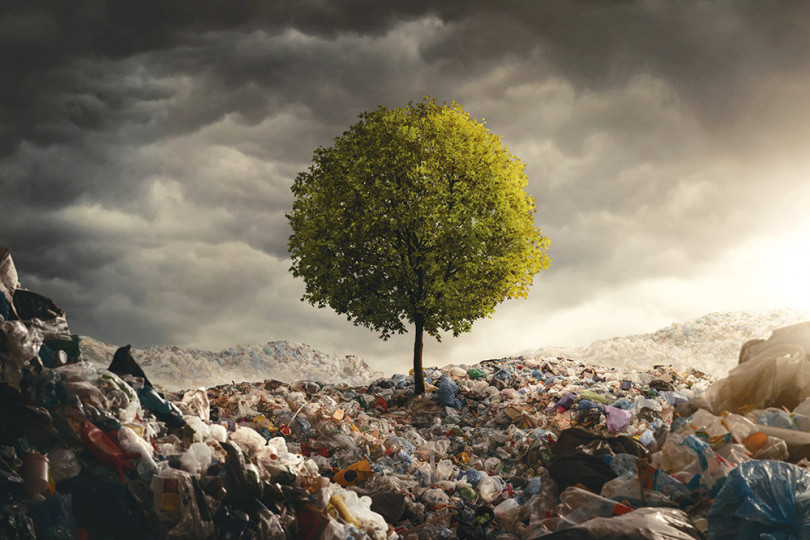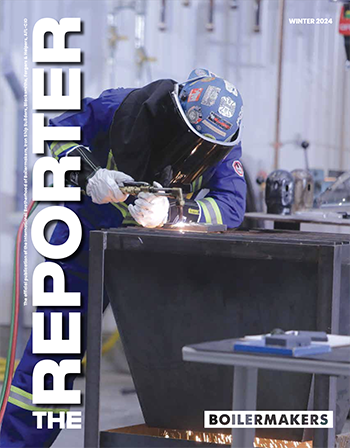We need the fossil fuel industry in order to manufacture the renewable industry.
The conversation about climate change is nearing fever pitch in North America, especially among the liberal political class and radical environmentalists, with the push to 100% renewables their rallying cry. Few doubt that the world must act immediately to halt the effects of climate change. The Intergovernmental Panel on Climate Change recently released an alarming report on the critical state of the environment, calling for immediate action.
But as with many critical issues facing the United States and Canada, rhetoric and fearmongering abound, while workable, balanced solutions are ignored. Boilermakers are offering a measured and scientific approach to combating climate change: a mix of “all of the above” energy resources including fossil fuels outfitted with carbon capture, nuclear, renewables and clean fuels such as hydrogen.
“The time has come to put our best minds at work to finally address the challenges of climate change responsibly and rationally,” International President Newton B. Jones said.
What the screaming voices demanding 100% renewables aren’t admitting is the dirty little secret that renewables aren’t all that clean. They’re not going to tell you that hydro power creates methane. That there’s no plan for the recycling or disposal of solar panels, batteries and wind turbines. That mining in developing countries, needed for metals in batteries and other renewables, exploits people and decimates the earth. Or that harvesting needed metals, also found in ocean beds, creates myriad environmental problems.
Moving prematurely to 100% renewable energy can’t meet the world’s complex energy demands. Batteries need charging, and wind and solar power depend on the weather. Without stable, reliable energy sources, homes won’t have lights, heating or air conditioning. Increasingly extreme weather creates surges in the need for power, such as during the freeze that hit Texas in early 2021 and excessive heat waves this summer, which renewables can’t support. Moreover, essential industries that people depend upon daily consume large amounts of power, such as during the production of chemicals, metals, cement, paper, machinery, food and beverages.
The issue of climate change mitigation should not be an either/or situation yet extreme environmentalists would have the public and legislators believe they have the only solution. To find solutions to a warming climate, IVP-Western States J. Tom Baca would like to see the same trust, respect and cooperation between decision-makers that occurred in the past. When California first decided to do away with coal and move to gas turbines, he recalls the state was in the process of buying obsolete gas turbines. The California State Building Trades stepped in to guide the state through the transition. Union leaders helped state officials purchase the best and newest, quick start turbines. The trades saved the state money. And embarrassment.
“We were the buffer between the refineries and the environmentalists,” IVP Baca said. “There was a lot of give and take at the time.”
Unfortunately, that’s not what’s happening now. Across the U.S., policymakers seem to be listening solely to environmentalists, with little concern about the loss of middle-class jobs or the hidden problems with renewables.
 Solar power shines with toxicity
Solar power shines with toxicity
Solar power is one technology many believe can be a huge part of the answer to global energy needs. Solar panels are so popular, homeowners cover their rooftops with them. But what about the CO2 footprint needed to manufacture them? What’s the answer to their toxic metal disposal?
The science journal Joule cites a study done on the long-term carbon footprint in the manufacturing of today’s photovoltaic (PV) devices, commonly known as solar panels, which generate electricity directly from sunlight. They state: “Without further innovation, PV production will lead to significant CO2 emissions.” In future manufacturing of PV products Joule finds “these emissions will likely surpass those caused by the global shipping and aviation industry.”
The toxic footprint solar creates depends on the manufacturing process. Solar panels made in China, for example, create more CO2 than those produced in the European Union or the U.S. and Canada. But climate change is a worldwide concern. Even if North America cuts emissions, CO2 from China can also melt the ice caps and warm the planet.
And all solar panel manufacturing involves harmful chemicals and rare earth metals. That’s becoming a growing problem now that early panels are nearing the end of their lifecycle. Metals needed for production such as cadmium, lead and quartz, make panels toxic to recycle. Ironically, it takes considerable energy to extract the hazardous metals before recycling.
As with all “green” energy solutions, fossil fuels are needed to produce them.
“We need the fossil fuel industry in order to manufacture the renewable industry,” said International Director of Climate Change Policy Solutions, AD-CSO/Canada Cory Channon. “To build solar panels, for example, you need to mine coal and quartz.”
And mining has its own ethical problems. Before solar becomes even more widespread, science must find actual green solutions that won’t add to global emissions or exploit workers in other countries.
 Wind power generates a problematic breeze
Wind power generates a problematic breeze
Wind power has been around since the 1980s but really ramped up when the Obama Administration opened the money spigot for that industry, creating wind farms across the U.S.
At the end of their life, the fiberglass blades are dismantled, hauled away and dumped in landfills. One blade on a wind turbine can be longer than a wing on the Boeing 747. They can’t be recycled and they don’t decompose. Fortune magazine states that across the globe, tens of thousands of blades are coming down, headed to landfills—their final resting place. As with aging solar panels, the problem is worsening as 1980s-era wind turbine blades reach the end of their lifespan.
The pedestal itself comes from steel, which requires exhaustive mining for ore. “We need the high thermal energy to melt the ore and clear impurities,” Channon said. “It’s all energy intensive. As we go up further, the turbine has a lot of unique metals including copper.”
Rare earth metals are needed for magnets in the turbine’s operation. Many of these are not found in the U.S. and require ethically questionable mining in the developing world.
In addition, wind energy, along with other sources of renewable power, have a poor track record with energy reliability. “In the winter it’s a challenge,” Channon said. “Depending on where you’re living, the wind doesn’t always blow and the sun doesn’t always shine.”
 Hydropower swims with noxious gases
Hydropower swims with noxious gases
The Environmental Defense Fund, a think tank of environmental scientists founded in 1967, published a 2019 study in Environmental Science and Technology that shows hydropower isn’t as good for the environment as is broadly assumed. They write: “Moreover, continuing to assume that…could mean that projects meant to reduce greenhouse emissions will unintentionally increase them instead.”
The facts show that reservoirs can generate more CO2 and methane than does fossil fuel power generation, because as vegetation decomposes under water, carbon dioxide and methane are released.
“A hydro dam might not release emissions, but the reservoirs do,” Channon said. “And emissions are 10% higher than a fossil fuel plant.”
A 2013 study published by Norwegian University of Science and Technology found that CO2 from hydropower, per unit of electricity delivered, was 10% higher than that found in a natural gas-fired plant. Reservoirs also produce methane, even more harmful to the environment than CO2.
While many believe hydro projects are clean, “they’re not,” Channon said. “All the cement they’re using for the hydro project—that takes CO2 to produce.”
As the Environmental Defense Fund states: “Both carbon dioxide and methane are released when vegetation decomposes under water. And here, there are enormous differences from facility to facility due to a range of varying reservoir features and meteorological characteristics.”
What will make hydro power much greener is applying carbon capture to cement production used to create reservoirs.
 Battery-powered cars drive environmental and ethical harm
Battery-powered cars drive environmental and ethical harm
In 2020, California Gov. Gavin Newsom proclaimed that by 2035, all new cars and passenger trucks sold in California must be zero-emission vehicles. President Joe Biden recently announced that by 2030, 50% of all vehicles sold in the U.S. must be electric.
As political pandering, it reaches their base. As a practical solution, it fails. How does the nation ethically mine metals needed for batteries or ensure environmentally safe manufacturing? Is there a plan to dispose of toxic batteries?
As a recent article in Science Magazine states, “When the battery comes to the end of its life, its green benefits fade. If it ends up in a landfill, its cells can release problematic toxins, including heavy metals.”
And the mining of such rare earth metals to make the batteries can involve exploitation of people, often children, in the developing world. Channon wonders: “Have we lost our moral compass when we have children in the Congo mining metals for our renewable industry?”
As the United Nations Conference on Trade and Development states: “The expected boom in mining for the raw materials used to make rechargeable batteries raises environmental and social concerns that must be urgently addressed.” With more than half of the world’s lithium resources beneath the salt flats in the Andean regions of Argentina, Bolivia and Chile, the UNCTD notes that indigenous quinoa farmers and llama herders must now compete with miners for water in one of the world’s driest regions.
There are plans in the works to mine the seabed for needed minerals. A recent Los Angeles Times articles details scientists’ concerns.
“The debate over how much damage should be inflicted on the planet to save it may be most intense far out to sea. The Metals Co. and others plan within three years to start vacuuming patches of the deep ocean floor for nodules that contain many of the metals that go into electric car batteries along with lithium. Many scientists say the timeline is dangerously irresponsible.”
The LA Times wrote that potential mining of the seabed has so concerned experts more than 500 scientists from 44 countries are warning against mining, because there are currently too many unknowns. They fear mining could destroy ecosystems.
The Boilermakers and other unions in the building trades are not against renewables. Boilermakers want a sustainable planet just as much as environmentalists do. However, the union is against the push to 100% renewables when there are still multiple ethical, reliability and emission concerns yet to be solved.
What the world needs now is an “all of the above” energy solution with CCUS at the forefront as the world’s bridge to a clean energy future. By retrofitting existing fossil fuel plants, refineries and manufacturing facilities with CCUS, reliable energy is ensured while science continues to research solutions for dirty renewables and invent clean forms of energy production.
With everything I’m hearing, we have a bright future in clean energy across the country.
The building trades have been integral to making the environment cleaner. As they have in the past, Boilermakers will continue to lead the charge.
“With everything I’m hearing, we have a bright future in clean energy across the country,” IVP Baca said. “It’s coming if the environmentalists just leave us alone and let us do our job.”
Editor’s Note: This is the second in a series of three articles about energy production and climate change mitigation. Watch for an article in the Winter issue of The Boilermaker Reporter about carbon capture, use and storage—the bridge to a clean energy future.






